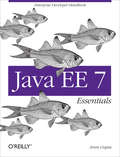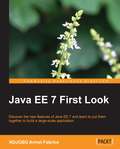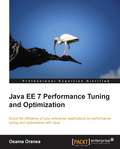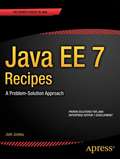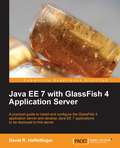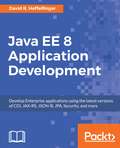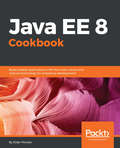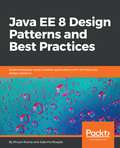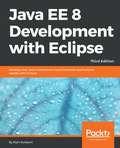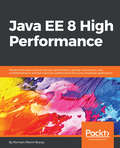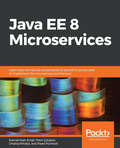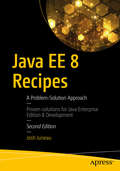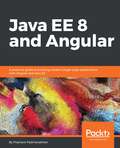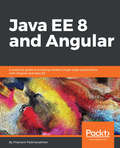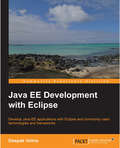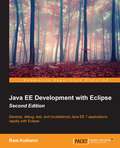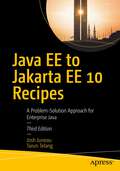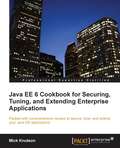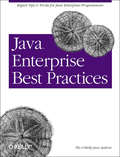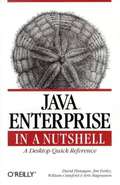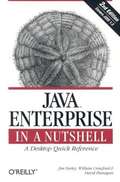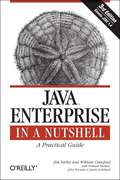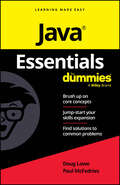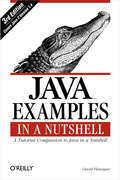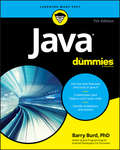- Table View
- List View
Java EE 7 Essentials: Enterprise Developer Handbook
by Arun GuptaGet up to speed on the principal technologies in the Java Platform, Enterprise Edition 7, and learn how the latest version embraces HTML5, focuses on higher productivity, and provides functionality to meet enterprise demands. Written by Arun Gupta, a key member of the Java EE team, this book provides a chapter-by-chapter survey of several Java EE 7 specifications, including WebSockets, Batch Processing, RESTful Web Services, and Java Message Service.You’ll also get self-paced instructions for building an end-to-end application with many of the technologies described in the book, which will help you understand the design patterns vital to Java EE development.Understand the key components of the Java EE platform, with easy-to-understand explanations and extensive code samplesExamine all the new components that have been added to Java EE 7 platform, such as WebSockets, JSON, Batch, and ConcurrencyLearn about RESTful Web Services, SOAP XML-based messaging protocol, and Java Message ServiceExplore Enterprise JavaBeans, Contexts and Dependency Injection, and the Java Persistence APIDiscover how different components were updated from Java EE 6 to Java EE 7
Java EE 7 First Look
by Ndjobo Armel FabriceAn easy-to-follow guide to reveal the new features of Java EE 7 and how to efficiently utilize them.Given the main objectives pursued, this book targets three groups of people with a knowledge of the Java language. They are:Beginners in the Java EE platform who would like to have an idea about the main specifications of Java EE 7.Developers who have experimented with previous versions of Java EE and who would like to explore the new features of Java EE 7.Building architects who want to learn how to put together the various Java EE 7 specifications for building robust and secure enterprise applications.
Java EE 7 Performance Tuning and Optimization
by Osama OransaThe book adopts a step-by-step approach, starting from building the basics and adding to it gradually by using different tools and examples. The book sequence is easy to follow and all topics are fully illustrated showing you how to make good use of different performance diagnostic tools. If you are an experienced Java developer, architect, team leader, consultant, support engineer, or anyone else who needs performance tuning in your Java applications, and in particular, Java enterprise applications, this book is for you. No prior experience of performance tuning is required.
Java EE 7 Recipes: A Problem-Solution Approach
by Josh JuneauJava EE 7 Recipes takes an example-based approach in showing how to program Enterprise Java applications in many different scenarios. Be it a small-business web application, or an enterprise database application, Java EE 7 Recipes provides effective and proven solutions to accomplish just about any task that you may encounter. You can feel confident using the reliable solutions that are demonstrated in this book in your personal or corporate environment. The solutions in Java EE 7 Recipes are built using the most current Java Enterprise specifications, including EJB 3.2, JSF 2.2, Expression Language 3.0, Servlet 3.1, and JMS 2.0. While older technologies and frameworks exist, it is important to be forward-looking and take advantage of all that the latest technologies offer. Rejuvenate your Java expertise to use the freshest capabilities, or perhaps learn Java Enterprise development for the first time and discover one of the most widely used and most powerful platforms available for application development today. Let Java EE 7 Recipes show you the way by showing how to build streamlined and reliable applications much faster and easier than ever before by making effective use of the latest frameworks and features on offer in the Java EE 7 release. Shows off the most current Java Enterprise Edition technologies. Provides solutions to creating sophisticated user interfaces. Demonstrates proven solutions for effective database access.
Java EE 7 with GlassFish 4 Application Server
by David R. HeffelfingerThis book is a practical guide and follows a very user-friendly approach. The book aims to get the reader up to speed in Java EE 7 development. All major Java EE 7 APIs and the details of the GlassFish 4 server are covered followed by examples of their use. If you are a Java developers who wants to become proficient with Java EE 7 this book is ideal for you. Readers are expected to have some experience with Java and to have developed and deployed applications in the past, but don’t need any previous knowledge of Java EE or J2EE. It teaches the reader how to use GlassFish 4 to develop and deploy applications.
Java EE 8 Application Development
by David R. HeffelfingerDevelop Enterprise Java applications compliant with the latest version of the Java EE specification About This Book • This book covers all of the major Java EE 8 APIs and includes new additions such as enhanced Security, JSON-B Processing, and more • Learn additional Java EE APIs, such as the Java API for Websocket and the Java Message Service (JMS) • Develop applications by taking advantage of the latest versions of CDI, Security, Servlets, and JSF and other Java EE specifications Who This Book Is For If you are a Java developer who wants to become proficient with Java EE 8, this book is ideal for you. You are expected to have some experience with Java and to have developed and deployed applications in the past, but you don't need any previous knowledge of Java EE. What You Will Learn • Develop and deploy Java EE applications • Embrace the latest additions to the Contexts and Dependency Injection (CDI) specification to develop Java EE applications • Develop web-based applications by utilizing the latest version of JavaServer Faces, JSF 2.3. • Understand the steps needed to process JSON data with JSON-P and the new JSON-B Java EE API • Implement RESTful web services using the new JAX-RS 2.1 API, which also includes support for Server-Sent Events (SSE) and the new reactive client API In Detail Java EE is an Enterprise Java standard. Applications written to comply with the Java EE specification do not tie developers to a specific vendor; instead they can be deployed to any Java EE compliant application server. With this book, you'll get all the tools and techniques you need to build robust and scalable applications in Java EE 8. This book covers all the major Java EE 8 APIs including JSF 2.3, Enterprise JavaBeans (EJB) 3.2, Contexts and Dependency Injection (CDI) 2.0, the Java API for WebSockets, JAX-RS 2.1, Servlet 4.0, and more. The book begins by introducing you to Java EE 8 application development and goes on to cover all the major Java EE 8 APIs. It goes beyond the basics to develop Java EE applications that can be deployed to any Java EE 8 compliant application server. It also introduces advanced topics such as JSON-P and JSON-B, the Java APIs for JSON processing, and the Java API for JSON binding. These topics dive deep, explaining how the two APIs (the Model API and the Streaming API) are used to process JSON data. Moving on, we cover additional Java EE APIs, such as the Java API for Websocket and the Java Message Service (JMS), which allows loosely coupled, asynchronous communication. Further on, you'll discover ways to secure Java EE applications by taking advantage of the new Java EE Security API. Finally, you'll learn more about the RESTful web service development using the latest JAX-RS 2.1 specification. You'll also get to know techniques to develop cloud-ready microservices in Java EE. Style and approach The book takes a pragmatic approach, showing you various techniques to utilize new features of Java EE 8 specification. It is packed with clear, step-by-step instructions, practical examples, and straightforward explanations.
Java EE 8 Cookbook: Build reliable applications with the most robust and mature technology for enterprise development
by Elder MoraesA practical guide for building effective enterprise solutions with Java EE 8Key FeaturesRecipes to get you up-and-running with Java EE 8 application development Learn how to apply the major Java EE 8 APIs and specificationsImplement microservices and Reactive programming with Java EE 8Book DescriptionJava EE is a collection of technologies and APIs to support Enterprise Application development. The choice of what to use and when can be dauntingly complex for any developer. This book will help you master this. Packed with easy to follow recipes, this is your guide to becoming productive with Java EE 8.You will begin by seeing the latest features of Java EE 8, including major Java EE 8 APIs and specifications such as JSF 2.3, and CDI 2.0, and what they mean for you.You will use the new features of Java EE 8 to implement web-based services for your client applications. You will then learn to process the Model and Streaming APIs using JSON-P and JSON-B and will learn to use the Java Lambdas support offered in JSON-P. There are more recipes to fine-tune your RESTful development, and you will learn about the Reactive enhancements offered by the JAX-RS 2.1 specification.Later on, you will learn about the role of multithreading in your enterprise applications and how to integrate them for transaction handling. This is followed by implementing microservices with Java EE and the advancements made by Java EE for cloud computing.The final set of recipes shows you how take advantage of the latest security features and authenticate your enterprise application.At the end of the book, the Appendix shows you how knowledge sharing can change your career and your life.What you will learnActionable information on the new features of Java EE 8Using the most important APIs with real and working codeBuilding server side applications, web services, and web applicationsDeploying and managing your application using the most important Java EE serversBuilding and deploying microservices using Java EE 8Building Reactive application by joining Java EE APIs and core Java featuresMoving your application to the cloud using containersPractical ways to improve your projects and career through community involvementWho this book is forThis book is for developers who want to become proficient with Java EE 8 for their enterprise application development. Basic knowledge of Java is assumed
Java EE 8 Design Patterns and Best Practices: Build enterprise-ready scalable applications with architectural design patterns
by Rhuan Rocha João PurificaçãoGet the deep insights you need to master efficient architectural design considerations and solve common design problems in your enterprise applications.Key FeaturesThe benefits and applicability of using different design patterns in JAVA EE Learn best practices to solve common design and architectural challengesChoose the right patterns to improve the efficiency of your programs Book DescriptionPatterns are essential design tools for Java developers. Java EE Design Patterns and Best Practices helps developers attain better code quality and progress to higher levels of architectural creativity by examining the purpose of each available pattern and demonstrating its implementation with various code examples. This book will take you through a number of patterns and their Java EE-specific implementations.In the beginning, you will learn the foundation for, and importance of, design patterns in Java EE, and then will move on to implement various patterns on the presentation tier, business tier, and integration tier. Further, you will explore the patterns involved in Aspect-Oriented Programming (AOP) and take a closer look at reactive patterns. Moving on, you will be introduced to modern architectural patterns involved in composing microservices and cloud-native applications. You will get acquainted with security patterns and operational patterns involved in scaling and monitoring, along with some patterns involved in deployment.By the end of the book, you will be able to efficiently address common problems faced when developing applications and will be comfortable working on scalable and maintainable projects of any size.What you will learnImplement presentation layers, such as the front controller patternUnderstand the business tier and implement the business delegate patternMaster the implementation of AOPGet involved with asynchronous EJB methods and REST servicesInvolve key patterns in the adoption of microservices architectureManage performance and scalability for enterprise-level applicationsWho this book is forJava developers who are comfortable with programming in Java and now want to learn how to implement design patterns to create robust, reusable and easily maintainable apps.
Java EE 8 Development with Eclipse: Develop, test, and troubleshoot Java Enterprise applications rapidly with Eclipse, 3rd Edition
by Ram KulkarniDevelop and deploy fully functional applications and microservices utilising Tomcat, Glassfish servers, Cloud and docker in Java EE 8 Key FeaturesExplore the complete workflow of developing enterprise Java applicationsDevelop microservices with Docker Container and deploy it in cloudSimplify Java EE application developmentBook DescriptionJava EE is one of the most popular tools for enterprise application design and development. With recent changes to Java EE 8 specifications, Java EE application development has become a lot simpler with the new specifications, some of which compete with the existing specifications. This guide provides a complete overview of developing highly performant, robust and secure enterprise applications with Java EE with Eclipse.The book begins by exploring different Java EE technologies and how to use them (JSP, JSF, JPA, JDBC, EJB, and more), along with suitable technologies for different scenarios. You will learn how to set up the development environment for Java EE applications and understand Java EE specifications in detail, with an emphasis on examples. The book takes you through deployment of an application in Tomcat, GlassFish Servers, and also in the cloud. It goes beyond the basics and covers topics like debugging, testing, deployment, and securing your Java EE applications. You'll also get to know techniques to develop cloud-ready microservices in Java EE.What you will learnSet up Eclipse, Tomcat, and Glassfish servers for Java EE application developmentUse JSP, Servlet, JSF, and EJBs to create a user interface and write business logicCreate Java EE database applications using JDBC and JPAHandle asynchronous messages using MDBs for better scalabilityDeploy and debug Java EE applications and create SOAP and REST web servicesWrite unit tests and calculate code coverageUse Eclipse MAT (Memory Analysis Tool) to debug memory issuesCreate and deploy microservicesWho this book is forIf you are a Java developer with little or no experience in Java EE application development, or if you have experience in Java EE technology but are looking for tips to simplify and accelerate your development process, then this book is for you.
Java EE 8 High Performance: Master techniques such as memory optimization, caching, concurrency, and multithreading to achieve maximum performance from your enterprise applications.
by Romain Manni-BucauGet more control of your applications performances in development and production and know how to meet your Service Level Agreement on critical microservices. Key Features Learn how to write a JavaEE application with performance constraints (Service Level Agreement—SLA) leveraging the platform Learn how to identify bottlenecks and hotspots in your application to fix them Ensure that you are able to continuously control your performance in production and during development Book Description The ease with which we write applications has been increasing, but with this comes the need to address their performance. A balancing act between easily implementing complex applications and keeping their performance optimal is a present-day need. In this book, we explore how to achieve this crucial balance while developing and deploying applications with Java EE 8. The book starts by analyzing various Java EE specifications to identify those potentially affecting performance adversely. Then, we move on to monitoring techniques that enable us to identify performance bottlenecks and optimize performance metrics. Next, we look at techniques that help us achieve high performance: memory optimization, concurrency, multi-threading, scaling, and caching. We also look at fault tolerance solutions and the importance of logging. Lastly, you will learn to benchmark your application and also implement solutions for continuous performance evaluation. By the end of the book, you will have gained insights into various techniques and solutions that will help create high-performance applications in the Java EE 8 environment. What you will learn Identify performance bottlenecks in an application Locate application hotspots using performance tools Understand the work done under the hood by EE containers and its impact on performance Identify common patterns to integrate with Java EE applications Implement transparent caching on your applications Extract more information from your applications using Java EE without modifying existing code Ensure constant performance and eliminate regression Who this book is for If you're a Java developer looking to improve the performance of your code or simply wanting to take your skills up to the next level, then this book is perfect for you.
Java EE 8 Microservices
by Mert Caliskan Pavel Pscheidl Ondrej MihalyiJavaEE developers who are eager to start building enterprise applications in the microservices architecture will find this book extremely useful.
Java EE 8 Recipes: A Problem-Solution Approach
by Josh JuneauQuickly find solutions to dozens of common programming problems with the Java Enterprise Edition Platform for small business web applications, enterprise database applications, and microservices solutions. Content is presented in the popular problem-solution format. Look up the programming problem that you want to solve. Read the solution. Apply the solution directly in your own code. Problem solved!Java EE 8 Recipes provides you with effective and proven solutions that can be used to accomplish just about any task that you may encounter. You can feel confident using the reliable solutions that are demonstrated in this book in your personal or corporate environment.Java is a mature programming language that has been refined over the years into a productive and lucrative language for those with the skills to wield it. One result of this years-long refining process is that that the language carries forward many older feature sets that no longer represent the best way of getting work accomplished. You can rest assured that Java EE 8 Recipes provides solutions using the most current approaches implemented in the most current Java Enterprise technologies, including JSON-P 1.1, JSF 2.3, and JAX-RS 2.1. Build a streamlined and reliable application that uses the latest in Java technologies, and develop it much faster than you did with the older technologies. Rejuvenate your Java expertise to use the freshest capabilities, or perhaps learn Java Enterprise development for the first time and discover one of the most widely used and most powerful technologies available for application development today. Develop productively. Develop with proven technology. Develop with Java Enterprise Edition. The book: Teaches how to develop RESTful enterprise applications quickly using the most current Java EE technologiesExplores different solutions for developing sophisticated web user interfacesWalks you through a myriad of different concepts to apply while working with databases using Java technologiesWhat You'll LearnDevelop Java Enterprise applications using the latest in Java EE technologiesBuild great-looking user interfaces using Java Server FacesEmploy Java Servlet technology and standard frameworks in developing professional web applicationsCreate enterprise-level database applications using Enterprise Java Beans and JAX-RS RESTFul web servicesMake use of Arquillian to build a cohesive test suite for Java EE applicationsManage Java EE application security through Java EE's container feature setWho This Book Is ForJava developers who want to develop effective and proven solutions without reading a lengthy manual and scrubbing for techniques. A beginning Java programmer will find the book handy for learning a variety of different solutions for the platform, while advanced developers will enjoy the ease of the problem-solution approach to quickly broaden their knowledge of the platform’s latest technologies.
Java EE 8 and Angular: Build Modern User Friendly Web Apps With Java Ee
by Prashant PadmanabhanThe demand for modern and high performing web enterprise applications is growing rapidly. No more is a basic HTML front-end enough to meet customer demands. This book will be your one stop guide to build outstanding enterprise web applications with Java EE and Angular. It will teach you how to harness the power of Java EE to build sturdy back ends while applying Angular on the front end. Your journey to building excellent web enterprise applications starts here!
Java EE 8 and Angular: Build modern user friendly web apps with Java EE
by Sukma Wardana Prashant PadmanabhanLearn how to build high-performing enterprise applications using Java EE powered by Angular at the frontend Key Features Leverage Java EE 8 features to build robust backend for your enterprise applications Use Angular to build a single page frontend and combine it with the Java EE backend A practical guide filled with ample real-world examples Book Description The need for high-performing web enterprise applications is growing rapidly. No longer is a basic HTML frontend enough to meet customer demands. This book will be your one-stop guide to build outstanding enterprise web applications with Java EE and Angular. It will teach you to harness the power of Java EE to build sturdy backends while applying Angular on the frontend. Your journey to building excellent web enterprise applications starts here! The book starts with a brief introduction to the fundamentals of Java EE and all the new APIs offered in the latest release. Armed with the knowledge of Java EE 8, you will cover what it’s like to build an end-to-end application, configure database connection for JPA, and build a scalable microservice using RESTful APIs running in Docker containers. Taking advantage of Payaramicro capabilities, you will build an Issue Management System, which will have various features as services using Java EE backend. With a detailed coverage of Angular fundamentals, the book will expand the Issue Management System by building a modern single page application frontend. Moving forward, you will learn to fit both the pieces together; both the frontend Angular application and the backend Java EE microservices. As each unit in a microservice promotes high cohesion, you will learn different ways in which independent units can be tested efficiently. The book ends on a high note—concepts on securing your enterprise applications. This is your ultimate guide to building Modern Web Applications. What you will learn Write CDI-based code in Java EE 8 applications Build an understanding of microservices and what they mean in a Java EE context Employ Docker to build and run microservice applications Use configuration optionsto work effectively with JSON documents Handle asynchronous task and write RESTAPI clients Set the foundation for working on Angular projects with the fundamentals of TypeScript Learn to use Angular CLI to add and manage new features Secure Angular applicationsusing malicious attacks adopting JSON Web tokensWho this book is for This book is for Java EE developers who would like to build modern enterprise web applications using Angular. No knowledge of Angular is required.
Java EE Development with Eclipse
by Deepak VohraThis book is step-by-step tutorial guide and a background reference for developing applications with Oracle WebLogic Server and Oracle database, the most used application server and database for enterprise applications. This book is for professional Java EE developers. The book is also suitable for an intermediate/advanced course in Java development with Eclipse IDE. Some knowledge of the Java EE technologies and frameworks EJB, JSF, JAXB, JAX-WS, JAX-RS, Ajax, and Spring is required.
Java EE Development with Eclipse - Second Edition
by Ram KulkarniDevelop, debug, test, and troubleshoot Java EE 7 applications rapidly with Eclipse About This Book * Go beyond simply learning Java EE APIs and explore the complete workflow of developing enterprise Java applications * Learn to use the features of Eclipse JEE to simplify Java EE application development * Develop and deploy complete applications with JEE Who This Book Is For If you are a Java developer who has little or no experience in JEE application development or you have experience in JEE technology but are looking for tips to simplify and accelerate your development process, then this book is for you. What You Will Learn * Set up Eclipse, Tomcat, and Glassfish server for JEE application development * Use JSP, Servlet, JSF, and EJBs to create a user interface and write business logic * Create JEE database applications using JDBC and JPA * Handle asynchronous messages using MDBs for better scalability * Deploy and debug JEE applications and create SOAP and REST web services * Write unit tests and calculate code coverage * Troubleshoot application performance and memory issues In Detail Java EE is a technology for developing enterprise class, scalable applications. With recent changes to Java EE specifications, JEE application development has become a lot simpler. However, recent changes have also added many new specifications, some of which compete with existing JEE specification. Along with JEE specifications and APIs, it is also very important to understand the entire application development process and tools that can help simplify and accelerate JEE application development. This guide provides a complete overview of developing JEE applications using Eclipse. The many features of the Eclipse IDE are explained. These enable the rapid development, debugging, testing, and deployment of JEE applications. You'll explore not just different JEE technologies and how to use them (JSP, JSF, JPA, JDBC, EJB, web services etc.), but also suitable technologies for different scenarios. The book starts with how to set up the development environment for JEE applications and then goes on to describe many JEE specifications in detail, with an emphasis on examples. You'll learn how to deploy an example application on Tomcat and Glassfish Application Server. You'll create a simple application that reads from a queue, processes the request, and publishes results to a topic and Eclipse MAT (Memory Analysis Tool) to debug memory issues. Style and approach This guide takes a step-by-step approach to developing, testing, debugging, and troubleshooting JEE applications, complete with examples and tips.
Java EE to Jakarta EE 10 Recipes: A Problem-Solution Approach for Enterprise Java
by Josh Juneau Tarun TelangTake a problem-solution approach for programming enterprise Java or Java EE applications and microservices for cloud-based solutions, enterprise database applications, and even small business web applications. Java EE to Jakarta EE 10 Recipes provides effective, practical, and proven code snippets that you can immediately use to accomplish just about any task that you may encounter. You can feel confident using the reliable solutions that are demonstrated in this book in your personal or corporate environment. Java EE was made open source under the Eclipse Foundation, and Jakarta EE is the new name for what used to be termed the Java Platform, Enterprise Edition. This book helps you rejuvenate your Java expertise and put the platform’s latest capabilities to use for quickly developing robust applications. If you are new to Jakarta EE, this book will help you learn the features of the platform and benefit from one of the most widely used and powerful technologies available for cloud-native enterprise application development today. Examples in this book highlight Jakarta EE’s capabilities, helping you to build streamlined and reliable applications using the latest in Java technologies. The book takes a problem-solution approach in which each section introduces a common programming problem, showing you how to solve that problem in the best possible way using the latest features in Jakarta EE. Solutions in the form of working code examples are presented that you can download and use immediately in your own projects. Clear descriptions are provided to help you understand and learn to build further on the solutions provided. This is the ideal book for the code-focused programmer interested in keeping up with the future of enterprise development on the Java Platform. What You Will Learn Develop enterprise java applications using the latest open-source Jakarta EE platformCreate great-looking user interfaces using Jakarta Servlets, Jakarta Server Pages, Jakarta Server Faces and the Eclipse Krazo framework (an implementation of Jakarta MVC)Build database applications using Jakarta NoSQL, Jakarta Persistence, and Jakarta Enterprise Beans.Develop enterprise grade applications using Context & Dependency Injection, and Jakarta RESTFul web servicesAutomate testing through cohesive test suites built on Arquillian for Jakarta EE applicationsBuild loosely coupled distributed applications using Jakarta MessagingDeploy microservices applications in cloud environments using DockerSecure applications utilizing the Jakarta EE Security API Who This Book Is For Java developers interested in quickly finding effective and proven solutions without reading through a lengthy manual and scrubbing for techniques.
Java EE6 Cookbook for securing, tuning, and extending enterprise applications
by Mick KnutsonThis book is part of Packt's Cookbook series. A Packt Cookbook contains step-by-step recipes for solutions to the most important problems you face when working with a topic. This book is aimed at Java developers and programmers who want to secure, tune and, extend their Java EE applications.
Java Enterprise Best Practices
by O'Reilly Java AuthorsJava developers typically go through four "stages" in mastering Java. In the first stage, they learn the language itself. In the second stage, they study the APIs. In the third stage, they become proficient in the environment. It is in the fourth stage --"the expert stage"-- where things really get interesting, and Java Enterprise Best Practices is the tangible compendium of experience that developers need to breeze through this fourth and final stage of Enterprise Java mastery. Crammed with tips and tricks, Java Enterprise Best Practices distills years of solid experience from eleven experts in the J2EE environment into a practical, to-the-point guide to J2EE. Java Enterprise Best Practices gives developers the unvarnished, expert-tested advice that the man pages don't provide--what areas of the APIs should be used frequently (and which are better avoided); elegant solutions to problems you face that other developers have already discovered; what things you should always do, what things you should consider doing, and what things you should never do--even if the documentation says it's ok. Until Java Enterprise Best Practices, Java developers in the fourth stage of mastery relied on the advice of a loose-knit community of fellow developers, time-consuming online searches for examples or suggestions for the immediate problem they faced, and tedious trial-and-error. But Java has grown to include a huge number of APIs, classes, and methods. Now it is simply too large for even the most intrepid developer to know it all. The need for a written compendium of J2EE Best Practices has never been greater. Java Enterprise Best Practices focuses on the Java 2 Enterprise Edition (J2EE) APIs. The J2EE APIs include such alphabet soup acronyms as EJB, JDBC, RMI, XML, and JMX.
Java Enterprise in a Nutshell
by Jim Farley David Flanagan William Crawford Kris MagnussonJava Enterprise in a Nutshell is an indispensable quick reference for Java programmers who are writing distributed enterprise applications. The book provides fast-paced tutorials on the following Java Enterprise APIs: JDBC, a vendor-independent API for accessing relational database systems RMI, a Java-only approach to distributed computing that relies on remote method invocation Java IDL, a CORBA-based, language-independent approach to distributed computing Java servlets, a mechanism for extending a web server that allows Java code to perform tasks traditionally handled by CGI scripts JNDI, a generic Java API for working with networked naming and directory services Enterprise JavaBeans, a component model that separates high-level business logic from low-level housekeeping chores like security and transaction management These APIs are the building blocks of the Java 2 Platform, Enterprise Edition (J2EE), Sun's recently announced new platform for enterprise computing. J2EE is the standard Java 2 platform with a number of extensions for enterprise development. Java Enterprise in a Nutshell also contains O'Reilly's classic-style, quick-reference material for all of the classes in the various packages that comprise the Enterprise APIs. This material includes the core Enterprise APIs that are part of Java 1.2, as well as numerous standard extensions. This book is a companion to both Java in a Nutshell, 3rd Edition, which covers the key non-graphical, non-enterprise APIs in Java 1.2, and Java Foundation Classes in a Nutshell, which describes the graphics- and GUI-related classes of Java 1.2.
Java Enterprise in a Nutshell, 2nd Edition
by Jim Farley David Flanagan William CrawfordNothing is as constant as change, and this is as true in enterprise computing as anywhere else. Since Java Enterprise in a Nutshell was first published in September of 1999, a dozen or more new APIs have been added to the platform, reflecting the new and different ways developers implement their enterprise objectives. And now developers are being called on to add even greater, more complex levels of interconnectivity to their applications, as the concepts behind Web Services solidify and implementation decisions need coding. Java developers today need a clear understanding of the new APIs, tools, capabilities and pitfalls in J2EE 2.0 so they can plan a technology and implementation strategy for new enterprise projects. Fortunately, this is exactly what they get with the new Java Enterprise in a Nutshell, 2nd edition ! Completely revised and updated for the new 2.0 version of Sun Microsystems Java Enterprise Edition software, Java Enterprise in a Nutshell 2nd edition covers all of the J2EE APIs, including RMI, Java IDL, JDBC, JNDI, Java Servlet, and Enterprise JavaBeans, with a fast-paced tutorial and compact reference on each technology. Then Java Enterprise in a Nutshell goes even further, providing a classic O'Reilly-style quick reference for all of the classes in the various packages that comprise the Enterprise APIs - covering the core enterprise APIs as well as numerous standard extensions.
Java Enterprise in a Nutshell, 3rd Edition
by Jim Farley William CrawfordNothing is as constant as change, and this is as true in enterprise computing as anywhere else. With the recent release of Java 2 Enterprise Edition 1.4, developers are being called on to add even greater, more complex levels of interconnectivity to their applications. To do this, Java developers today need a clear understanding of how to apply the new APIs, use the latest open source Java tools, and learn the capabilities and pitfalls in Java 2 Enterprise Edition 1.4 -- so they can plan a technology and implementation strategy for new enterprise projects. Fortunately, this is exactly what they get with the new Java Enterprise in a Nutshell , 3rd Edition. Because most integrated development environments (IDE) today include API lookup, we took out the main API sections from our previous edition to make room for new chapters, among others, on Ant, Cactus, Hibernate, Jakarta Struts, JUnit, security, XDoclet, and XML/JAXP. Revised and updated for the new 1.4 version of Sun Microsystems Java Enterprise Edition software, Java Enterprise in a Nutshell , 3rd Edition is a practical guide for enterprise Java developers.
Java Essentials For Dummies
by Doug Lowe Paul McFedriesSwiftly brush up on the foundations of Java programming Java Essentials For Dummies is a reliable and succinct reference on the core components of Java—the multifaceted general-purpose language used for desktop, mobile, and web applications. This straightforward book gets right to the point—eliminating review material and wordy explanations—so you get what you need, fast. Strengthen your understanding of the basics of coding with Java Review what you've already learned or pick up key skills Use Java to build a variety of applications and more Jog your memory on the essentials as you work and get clear answers to your questions Perfect for supplementing classroom learning, reviewing for a certification, or staying knowledgeable on the job, Java Essentials For Dummies is a direct reference that's great to keep on hand as an everyday desk reference.
Java Examples in a Nutshell: A Tutorial Companion to Java in a Nutshell
by David FlanaganThe author of the best-selling Java in a Nutshell has created an entire book of real-world Java programming examples that you can learn from. If you learn best "by example," this is the book for you.This third edition covers Java 1.4 and contains 193 complete, practical examples: over 21,900 lines of densely commented, professionally written Java code, covering 20 distinct client-side and server-side APIs. It includes new chapters on the Java Sound API and the New I/O API. The chapters on XML and servlets have been rewritten to cover the latest versions of the specifications and to demonstrate best practices for Java 1.4. New and updated examples throughout the book demonstrate many other new Java features and APIs.Java Examples in a Nutshell is a companion volume to Java in a Nutshell, Java Foundation Classes in a Nutshell, and Java Enterprise in a Nutshell. It picks up where those quick references leave off, providing a wealth of examples for both novices and experts. This book doesn't hold your hand; it simply delivers well-commented working examples with succinct explanations to help you learn and explore Java and its APIs.Java Examples in a Nutshell contains examples that demonstrate:Core APIs, including I/O, New I/O, threads, networking, security, serialization, and reflectionDesktop APIs, highlighting Swing GUIs, Java 2D graphics, preferences, printing, drag-and-drop, JavaBeans, applets, and soundEnterprise APIs, including JDBC (database access), JAXP (XML parsing and transformation), Servlets 2.4, JSP 2.0 (JavaServer Pages), and RMIThe book begins with introductory examples demonstrating structured and object-oriented programming techniques for new Java programmers. A special index at the end of the book makes it easy to look up examples that use a particular Java class or accomplish a desired task. In between, each chapter includes exercises that challenge readers and suggest further avenues for exploration.
Java For Dummies
by Barry A. BurdA new edition of the bestselling guide to Java If you want to learn to speak the world’s most popular programming language like a native, Java For Dummies is your ideal companion. With a focus on reusing existing code, it quickly and easily shows you how to create basic Java objects, work with Java classes and methods, understand the value of variables, learn to control program flow with loops or decision-making statements, and so much more! Java is everywhere, runs on almost any computer, and is the engine that drives the coolest applications. Written for anyone who’s ever wanted to tackle programming with Java but never knew quite where to begin, this bestselling guide is your ticket to success! Featuring updates on everything you’ll encounter in Java 9—and brimming with tons of step-by-step instruction—it’s the perfect resource to get you up and running with Java in a jiffy! Discover the latest features and tools in Java 9 Learn to combine several smaller programs to create a bigger program Create basic Java objects and reuse code Confidently handle exceptions and events If you’re ready to jump into Java, this bestselling guide will help keep your head above water!
